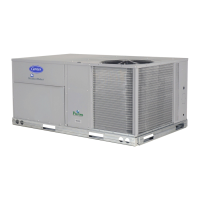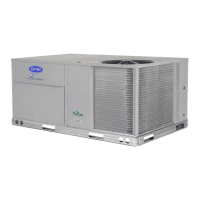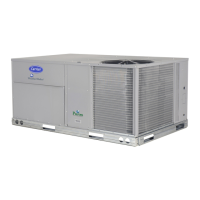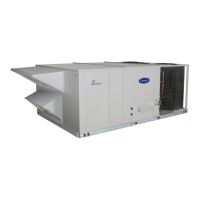49
Loca te the enthal py control in the ec onomizer hood.
Locate two GRA leads in the factory harness and connect
these leads to enthalpy control sensors 2 and 3. (See Fig.
49.) Connect the enthalpy control powe r input terminals to
economizer actuator power leads RED (connect to TR)
and BLK (conne ct to TR1).
The outdoor enthalpy changeover setpoint is set at the
enthalpy controller.
The enthalpy control receives the outdoor air enthalpy
from the outdoor air enthalpy sensor a nd provides a dry
conta ct switch input to the RT U--MP controller. A closed
contact indicates that outside air is preferred to the return
air. An open contact indicates that the economize r should
remain at minimum position.
Differential Enthalpy Control — Differential enthalpy
control is provided by sensing and comparing the outside
air and return air enthal py conditions. Install the outdoor
air enthalpy control as described above. Add and install a
return air enthalpy sensor.
Return Air Ent halpy Sensor — Mount the return--air
entha lpy sensor (HH57AC078) in the return--air duct. The
return air sensor is wired to the enthalpy controller
(HH57AC077). (See Fig. 50.)
To wire the return air enthalpy sensor, perform the
following:
1. Use a 2--conductor, 18 or 20 AWG, twisted pair cable
to connect the return air enthalpy sensor to the
enthalpy controller.
2. At the enthalpy control remove the factory--installed
resistor from the (SR) and (+) termina ls.
3. Connect the field--supplied RED wire to (+) spade
connec tor on the return air e nthalpy sensor and the
(SR+) terminal on the enthalpy controller. Connect
the BLK wire to (S) spade connector on the ret urn air
entha lpy sensor and the (SR) terminal on the enthalpy
controller.
NOTE: The enthalpy control must be set to the “D”
setting for differential enthalpy c ontrol to work properly.
The enthalpy c ontrol receives the indoor and return
enthalpy from the outdoor and return air entha lpy sensors
and provides a dry contact switch input to the RTU --MP
controller. A closed contact indica tes that outside air is
preferred to the return air. An open contact indicates that
the economizer should remain at minimum position.
Indoor Air Quality (CO
2
sensor) — The indoor air quality
sensor accessory monitors space carbon dioxide (CO
2
)
levels. This information is used to monitor IAQ levels.
Several types of sensors are available, for wall mounting
in the spac e or in return duct, with and without LCD
display, and in combination with space temperature
sensors. Sensors use infrared technol ogy to measure the
levels of CO
2
present in the space air.
The CO
2
sensors are all factory set for a range of 0 to
2000 ppm and a linear m A output of 4 to 20. Refer to the
instructions supplied with the CO
2
sensor for electrical
requirements and terminal locations. See Fig. 51 for
typical CO
2
sensor wiring schema tic.
To accurately monitor the quality of the air in the
conditioned a ir space, locate the sensor near a return--air
grille (if present) so it senses the concentration of CO
2
leaving the space. The sensor should be mounted in a
location to avoid direct breath contact.
Do not mount the IAQ sensor in drafty areas such as nea r
supply ducts, open windows, fans, or over heat sources.
Allow at least 3 ft (0.9 m) between the sensor and any
corner. Avoid mounting t he sensor where it is i nfluenced
by the supply air; the sensor gives inaccurate readings if
the supply air is blown directly onto the sensor or if the
supply air does not have a chance to mix with the room air
before it is drawn into the return airstream.
Wiring the Indoor Air Quality Sensor —
For each sensor, use two 2--conductor 18 AWG (American
Wire Gage) twisted--pair cables (unshielded) t o connect
the separate isolated 24 vac power source to the sensor
and to connect the sensor to the control board terminals.
To connect the sensor to the control, identify the positive
(4 to 20 mA) and ground (SIG COM) terminals on the
sensor. See Fig. 51. Connect the 4--20 mA terminal t o
RTU --MP J4--2 and connect the SIG COM terminal to
RTU--MP J4--3. See Fig. 65.
SEN
COM
J4-2
J4-3
IAQ Sensor
24 VAC
C08462
Fig. 65 -- RTU--MP / Indoor CO
2
Sensor
(33ZCSENCO2) Connections
Outdoor Air Quality Sensor (PNO 33ZCSENCO2 plus
weathe rproof enclosure) — The outdoor ai r CO
2
sensor is
designed to monitor carbon dioxide (CO
2
) levels in the
outside ventilation air and interface with the ventilation
damper in an HVAC system. The OAQ sensor is packaged
with an outdoor cover. (See Fig. 53.) T he outdoor air CO
2
sensor must be located in the economizer outside air hood.
Wiring t he Outdoor Air CO
2
Sensor — A dedicated power
supply is required for this sensor. A two--wire c able is
required to wire the dedica ted power supply for the sensor.
The two wire s should be connected to the power supply
and terminals 1 and 2.
48TC

